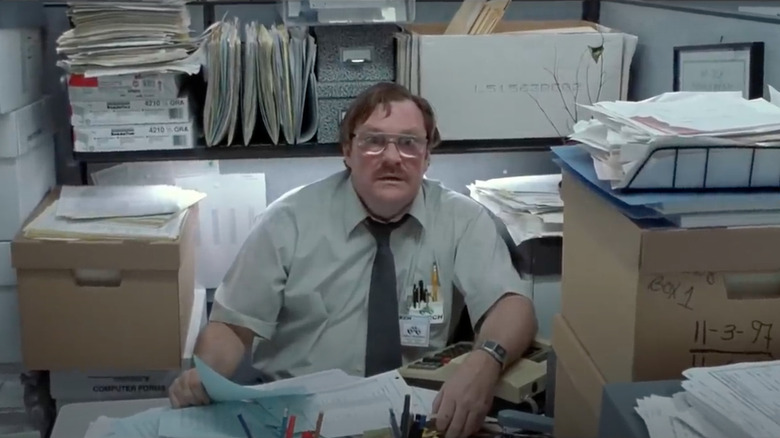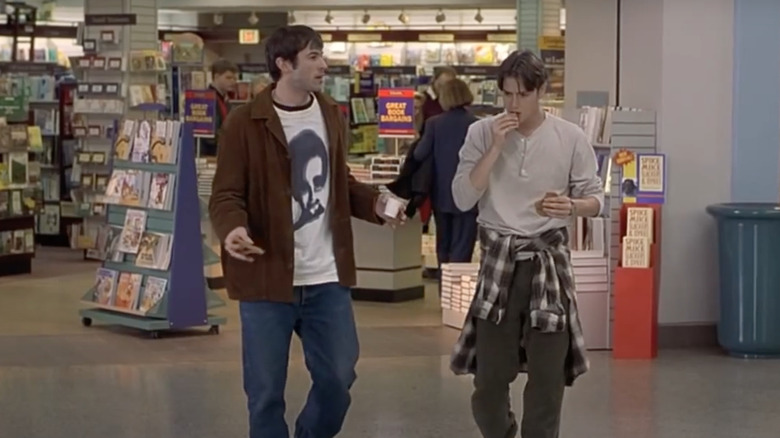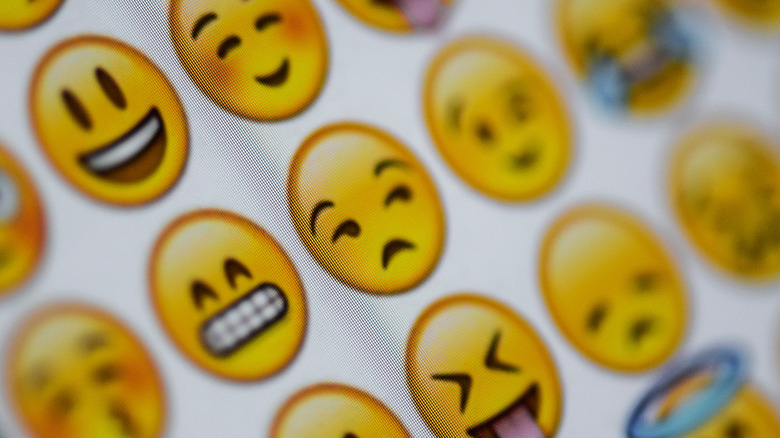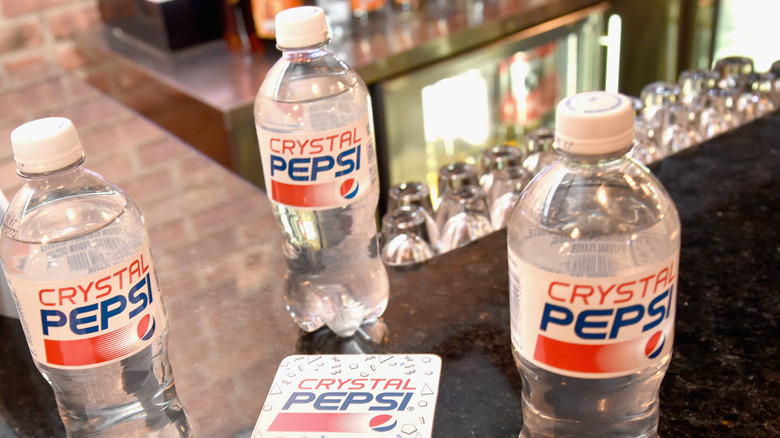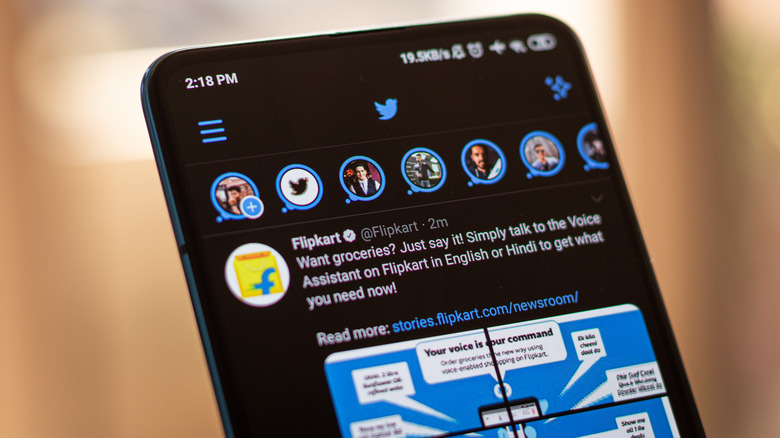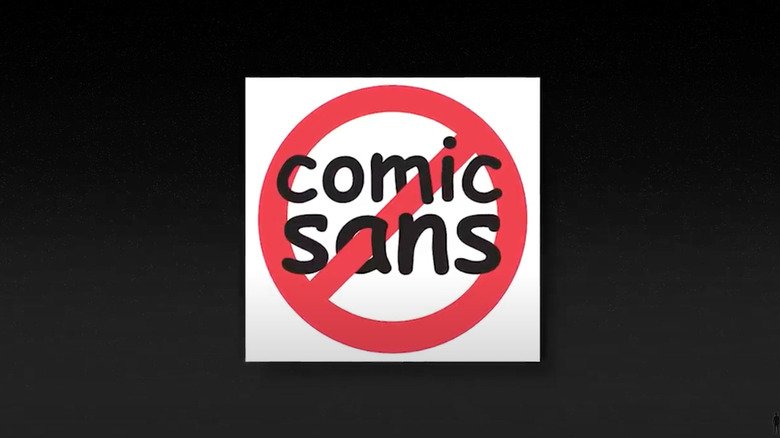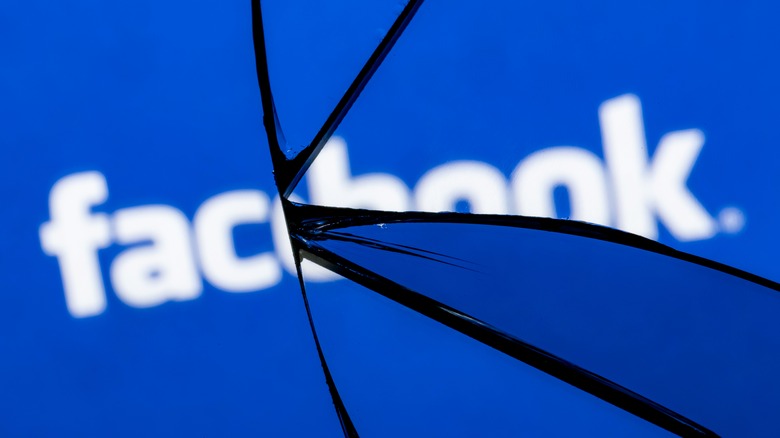People Who Were Ruined By Their Greatest Creation
You come up with an idea nobody ever thought of before. Somehow, you manage to get it noticed by the right eyes, and it blows up into an entire phenomenon. Then you walk away with wads of money and retire to your own private island. That's how it works, right?
Some of the most famous — and ubiquitous — inventions ever ended up becoming maligned by none other than their own creators. Most live with regret, and some have had their reputations all but annihilated after coming up with things such as cubicles, hoverboards, and even the Internet. This isn't a case of malicious intent. Smartphone games that can pass the time on a subway or social media that allows you to network with people who might be on the other side of the planet aren't inherently evil. The problem is that they had some unexpected, unwanted side effects that forever changed the way they were seen.
If you never thought someone would regret breeding Labradoodles, putting Facebook online, or creating Crystal Pepsi (maybe that last one), you're about to be surprised.
Dong Nguyen
Programmer Dong Nguyen was really just messing around when he dreamed up the mobile game "Flappy Bird." It went viral out of nowhere, but not long after, it began to destroy him.
On a break from his day job programming GPS devices, Nguyen felt inspired by the Nintendo games he grew up, according to Rolling Stone. He created what would later become a monster. "Flappy Bird" hatched for free on the iOS app store, where it seemingly went unnoticed until it flew higher than anyone ever expected. Phone gamers couldn't get enough of trying to maneuver this pixelated bird through pipes that were in the way without crashing. "Flappy Bird" boasted over 50 million downloads and paid out $50,000 a day to Nguyen, who wanted nothing to do with the press, but was going to get caught up in a scandal anyway.
Media outlets began harassing Nguyen with accusations of ripping off Nintendo art. The rumors went almost as viral as the game, and it got so intense he finally decided to take the game down, tweeting the news to millions of disappointed fans, who retweeted it over 100,000 times. He later told Forbes that he really trashed "Flappy Bird" because it had too many players interminably glued to their screens.
Wally Conron
Wait, how could such an adorable dog have been a massive mistake? The Labradoodle — a labrador-poodle mix — was the first "designer dog" that was never intended to be one. Breeder Wally Conron told ABC News Australia he bred this creature as a guide dog for someone allergic to dogs. Conron was a guide dog breeder used to breeding Labradors. He thought that a mashup between a lab and a poodle would end up in a canine companion that would be as competent a guide dog as a lab with a poodle's hypoallergenic coat.
There was an issue. Out of the three pups born in the first litter, only one wouldn't have its future owner reaching for tissues all the time. Though Conron tried to get the other two adopted, nobody wanted them, even people in need of a guide dog. Then something unexpected happened. More and more people wanted in on this breed.
Such a demand for Labradoodles spawned that breeders who were far from legit started merging poodles and labs so they could have bragging rights. Their easygoing temperament has made them more popular than Conron ever expected, according to the BBC. In an interview with ABC News Australia, he admitted that he had crossed into territory he shouldn't have. "I opened a Pandora's box and released a Frankenstein's monster," Conron said in regret. "When I'm out and I see these Labradoodles I can't help myself, I go over them in my mind."
Robert Propst
The object of endless satire from "Office Space" to "The Office," cubicles were invented by Robert Propst in 1968, as Business Insider remembers. The intent was to give workers more freedom and privacy. It backfired.
What Propst was going for was something with much more breathing room than the boxy stereotype that runs rampant today. Walls were supposed to be angled a certain way so that they would give employees the privacy they needed while being just open enough to allow their coworkers access when needed. There were supposed to be walls you could personalize along with multiple shelves and room to sit or stand at your desk. History Channel says that Propst realized a flexible space maximized his productivity, so he wanted to pass that on.
Unfortunately, corporations twisted Propst's intentions to shove people into boxes. There was no focus on the individual. Instead, they slashed costs by buying the least expensive materials possible for employees, and some executives would go so far as to snag the fancier furniture for themselves and leave the cheap stuff to the plebs. Huge corporate offices were using the cubicle idea to stuff as many people as possible into one space rather than give them the flexibility that was proposed by the original concept. Propst was horrified by what his invention had morphed into, and he took that regret to his grave.
Victor Gruen
From teen hangouts forever immortalized in movies like "Mallrats" to a scourge on suburbia, depending on how you see them, shopping malls have become a cultural icon. The problem is that their creator ended up feeling they should have never existed.
When architect Victor Gruen designed the first mall, the Austrian immigrant wasn't trying to contribute to suburban sprawl, but create a place that merged shopping and culture, according to Quartz. He also didn't imagine it as a hub of consumerism but a thriving complex where people could actually live. There would be stores, of course, but also schools, a hospital, and everything else to make such a community self-reliant. He opened his first mall, Southdale Center in Edina, Minnesota, in 1956. It was seen as revolutionary. There were fountains, art installations, and an aviary full of birds.
After malls kept devouring more and more land, Gruen realized his vision had created a monster. He watched as retailers only used the aspects of a mall that would generate the most profit, according to KCET LA. Malls became consumerist megaliths that would go on to multiply and make him regret what he started more and more. He saw that there was no effort made to turn malls into communities — and by the 1970s, America became overrun with them. Quartz says Gruen utterly despised suburban sprawl, but his nightmare came to life.
Scott Fahlman
You can't own a smartphone and not encounter emojis. They have become embedded in pop culture, going beyond texting and social media to digital stickers, merch, and even their own movie. It's almost impossible to imagine them not existing, but their creator now wishes they never did.
Emojis started out as emoticons. These prehistoric ancestors of emojis were created by computer science professor Scott Fahlman, who only wanted a way to communicate via internet (more like the internet's predecessor) in the early '80s, according to The Daily Beast. Nobody could tell who was serious and who was joking on online forums anymore. That was a problem since most of those forums involved theoretical physics, so Fahlman came up with ":-)" to identify jokes and the opposite ":-(" to let others know something was for real if they suspected it wasn't.
Though Fahlman didn't actually invent emojis — those first emerged in 1997 from Japanese cell phone company SoftBank — he is thought to have been an indirect influence. The use of emoticons spread so fast that he thought of it as some sort of digital virus that couldn't be annihilated fast enough. Emojis themselves have since evolved into digital stickers, some of which you actually have to pay for, according the Wall Street Journal. They function as emotions encapsulated in the form of cute, sometimes-snarky images such as a wombat giving you the side-eye. Texting could soon become obsolete.
David Novak
Remember Crystal Pepsi? Behind this caffeine-free soda was David Novak, who thought it was his best idea ever until it spilled all over. It just didn't taste enough like Pepsi.
In an essay he wrote himself on his own business website, Novak, the former head of marketing at Pepsi, explains what he learned from what he now considers his most egregious mistake. The bottlers tried voicing their concerns, and some taste testers reported an aftertaste, but nothing changed. He admits he thought he was too experienced a marketer to have to listen to anyone else. Instead, he decided to go with the backing from his own boss, positive responses from focus groups, and Dan Rather's mention of Crystal Pepsi on the CBS Evening News. He ended up launching it so fast that quality control was off. The sugary drink was alien to anyone who knew what Pepsi should taste like.
When Crystal Pepsi launched in 1992, there was a trend of "clear" and "pure" products ranging from soap to soda, as Business Insider remembers. This didn't necessarily mean there was any less sugar in this doomed version of Pepsi. There was just the illusion that it was somehow better for you. What Novak really regrets is not the invention itself, but coming up with it when he didn't have nearly as much experience as a business leader, and he believes he should have listened to his employees. It was resurrected for a limited run in 2016, however, because nostalgia.
Shane Chen
For anyone who ever wanted to ride like Marty McFly in "Back to the Future," the hoverboard was the next best thing to going airborne, but it didn't exactly translate from science fiction. You couldn't actually take to the air. However, staying earthbound was the least of the problems that its inventor, Shane Chen, had to face, as The Guardian found out.
Chen was not trying to be the next futuretech innovator. He originally invented the Hovertrax hoverboard, a contraption that looks like a skateboard with a huge wheel on either side, for pure fun, and even frequent falls (or the $1,000 price tag) couldn't stop it from selling out. Counterfeiters were onto this. Pretty soon, knockoffs were being produced en masse in China when Hovertrax had only put out a few thousand. These much cheaper versions tantalized McFly wannabes — even though Chen already had a patent. He ended up making nearly nothing from his creation as more and more knockoffs hit stores.
Besides being blatantly ripped off, Chen faced another issue. In 2021, News 4 San Antonio reported that some newer Hovertrax models were being recalled because they were prone to going up in flames. The boards are powered by lithium-ion batteries that can overheat. If the batteries get hot enough, they can even cause the board to explode. Whoever already had one was encouraged to send the battery pack back to parent company Razor for a replacement.
Tim Berners-Lee
The information superhighway has become plagued by misinformation. Never mind that it has also become infested with propaganda, private information that has been exposed, and even undercover operations. You might have been part of Facebook's secret 2012 psychological experiments without even knowing it, according to Vanity Fair. This is all the aftermath of a platform that was meant for nuclear scientists to share ideas but then grew tentacles and took on a life of its own.
Programmer Tim Berners-Lee morphed a defunct TV into his first computer. The prototype for what would eventually become the Internet was based on an existing system, something the government had been using to transmit classified messages since the '60s. Berners-Lee had no idea what he started when he released the code for the World Wide Web to the public. It didn't go viral immediately. There were other ways to zap information digitally, but when people started to realize the nearly endless potential of the Internet, it spread at warp speed. Suddenly, as The Guardian reports, social media boomed and the phenomenon of cyberbullying became a real concern. It is not so much the Internet itself but the way it evolved which bothered Berners-Lee.
"Given there are more webpages than there are neurons in your brain, it's a complicated thing," he told The Guardian in an interview where he expressed his regrets about what his brainchild had become.
Ethan Zuckerman
Speaking of the Internet, if you logged on during the late '90s and early '00s, you probably remember the barrage of pop-up ads that would hit your screen. Blame Ethan Zuckerman. As Forbes says, he really only wanted a way for companies to advertise without forcing you onto their sites.
Zuckerman (no relation to the father of Facebook) used to work on marketing-site-turned-website-host Tripod towards the end of the '90s. After experimenting with different methods of bringing in revenue, Zuckerman and his team found out that advertising was what brought the big bucks, but it took a completely new form. The program would find out what people were into and send them related ads. Pop-up ads were actually supposed to be less annoying by appearing in their own window instead of redirecting your current window to the brand's website. Despite the intent, they became one of the most maligned things on the Internet.
When an ad suddenly popped up on your screen, it gave you a choice, the way Zuckerman saw it in an interview with New York Magazine. You could click it and land on the website it was from if you were interested. If you weren't, you could just click out. What he didn't predict was how this would end up spiraling out of control. He was so regretful that he actually told Forbes, "I'm sorry."
Chris Whetherell
Tech developer Chris Whetherell just wanted to make it easier for people to share a tweet they found interesting. Enter the retweet button. Unfortunately, this led to the mass spreading of misinformation (often used to battle the opposing side) that has become an online epidemic.
There was an era before you could retweet someone with just a click. Back then, retweeting involved typing "RT" and the Twitter handle of the person who originally tweeted whatever it was, according to BuzzFeed News. You also had to copy and paste the text they wrote as well as any links they may have shared. Wetherell came up with a magic button that would do all that instantly. What he didn't realize at the time was that retweeting manually required more thought — what was it you were actually putting out there, and what implications could that have? Facebook soon jumped on the insta-sharing trend with its "share" button.
Twitter soon became volatile. That escalated with Gamergate, during which women in the gaming industry were bombarded with offensive retweets. The 2016 election also saw a storm of retweeted rumors. Wetherell realized you could just hit "retweet" ad nauseam and even set up retweet attacks without really thinking whether you were spreading false or harmful information. PC Magazine reports that Twitter is now trying to reimagine the retweet button by possibly making it mandatory to type in a message before you hit that button.
Vincent Connare
If you cringe whenever you see anything written in Comic Sans, you have Vincent Connare to thank, except he didn't set out to aggravate the universe when he designed it.
Comic Sans was supposed to be used for a character as cartoonish as the font itself, according to CBC Radio. No wonder it was inspired by actual comics such as "Watchmen." While the program that character was supposed to be a part of was scrapped, Comic Sans survived and hit home computers with Windows 95. Connare then watched the font go from an innocuous casual script to a digital beast. It seemed that the aesthetically inclined loathed Comic Sans, since the Wall Street Journal mentions that there now exists a worldwide movement to ban it. Then again, it's the same font on the tags of the once highly sought-after Beanie Babies, among other things.
It doesn't stop at a potential ban. As CBC Radio also says, the website Comic Sans Criminal is an archive of every inappropriate use of the font, which seems to trivialize messages from work emails to warning signs. Connare believes Comic Sans should only be reserved for more lighthearted situations, though he does admit to having sent a customer service complaint in that typeface just to aggravate someone into taking action (spoiler alert: it worked). That was the only time he ever used it. Connare's reputation might have been ruined by Comic Sans, but he has few regrets.
Sean Parker
Mark Zuckerburg may be the obvious poster child of Facebook, but former president Sean Parker has some heavy regrets about the social media platform where likes are everything, as he confessed to The Guardian. It seems borderline unbelievable for someone whose creation made him a billionaire.
"Likes" make users feel validated, the way Parker sees it. However, if you expect a post to accumulate hundreds of them and someone else's cat meme steals all the attention, you may end up feeling down. The dopamine boost was exactly why the "like" button was created in the first place. Zuckerberg, Parker, and the other founders of Facebook wanted it to absorb as much of your attention as possible, and part of that was constantly checking to see how many "likes," and therefore how much validation, you could get. This objective backfired. As he told Axios, he is now nervous about how it could affect focus and socialization.
Parker has gone so far as to speak out on his Facebook grievances publicly. At a 2017 Axios event, he recalled how he would convince everyone he possibly could to make a Facebook profile, even those who swore they would rather interact with others in person rather than through a social media app. He is also concerned, as he said, that it is "exploiting a vulnerability in human psychology." Has Facebook gone too deep? Only the future will tell.



